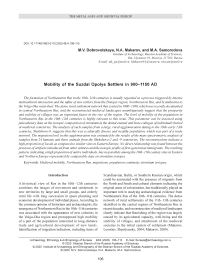Mobility of the Suzdal Opolye settlers in 900-1150 AD
Автор: Dobrovolskaya M.V., Makarov N.A., Samorodova M.A.
Журнал: Archaeology, Ethnology & Anthropology of Eurasia @journal-aeae-en
Рубрика: The metal ages and medieval period
Статья в выпуске: 4 т.48, 2020 года.
Бесплатный доступ
The formation of Northeastern Rus in the 10th–11th centuries is usually regarded as a process triggered by intense multicultural interaction and the infl ux of new settlers from the Dnieper region, Northwestern Rus, and Scandinavia to the Volga-Oka watershed. The dense rural settlement network that existed in 1000–1300, which was recently documented in central Northeastern Rus, and the reconstructed medieval landscapes unambiguously suggest that the prosperity and stability of villages was an important factor in the rise of the region. The level of mobility of the population in Northeastern Rus in the 10th–12th centuries is highly relevant to this issue. This parameter can be assessed using paleodietary data on the isotopic composition of strontium in the dental enamel and bone collagen of individuals buried at medieval cemeteries. The analysis of such samples from a large, rural agglomeration dating to the 10th–early 13th centuries, Shekshovo-9, suggests that this was a culturally diverse and wealthy population, which was part of a trade network. The migration level in this agglomeration was estimated by the results of the mass spectrometric analysis of samples from 24 humans and three animals from the Shekshovo-2 and -9 cemeteries. The reconstructions indicate a high proportion of locals as compared to similar sites in Eastern Europe. No direct relationship was found between the presence of artifacts introduced from other cultures and the isotopic profi le of fi rst-generation immigrants. The resulting pattern, indicating a high proportion of native individuals, has no parallels among the 10th–11th century sites in Eastern and Northern Europe represented by comparable data on strontium isotopes.
Medieval mobility, Northeastern Rus, migrations, population continuity, strontium isotopes
Короткий адрес: https://sciup.org/145146032
IDR: 145146032 | DOI: 10.17746/1563-0110.2020.48.4.106-115
Текст статьи Mobility of the Suzdal Opolye settlers in 900-1150 AD
A historical view of Rus in the 10th–12th centuries combines the images of movement and settlement in new territories by large and small groups, and orderly rural life with long succession in space planning and economic development of individual places. According to the common opinion of historians and archaeologists, the emergence of Northeastern Rus in the 10th–11th centuries was associated with the appearance of new colonists in the Volga-Oka region and presupposed high mobility of a part of the population interested in long-distance trade and agricultural development of new lands. Identification of migration indicators, including items of
Scandinavian, Baltic, or Southern Russian origin, which could be associated with the presence of migrants from the North and South and cultural elements indicating the original areas of colonization, has traditionally played an important role in studying archaeological evidence from Northeastern Rus of the 10th–11th centuries. The dense network of rural settlements of the 11th–13th centuries identified in the central regions of Northeastern Rus in recent decades, and reconstruction of medieval landscapes clearly indicate that flourishing of the region was largely caused by its agricultural capacity, well-being and the stability of villages, and attachment of the medieval societies to the initial centers of settlement (Makarov, Leontiev, Shpolyansky, 2004; Makarov, 2009).
The issue of the relationship between mobility and “sedentariness” in the society of Northeastern Rus in the 10th–12th centuries and level of mobility of the population living in rural areas is of paramount interest and involves the use of current bioarchaeological approaches to its solution. It is known, however, that most of the cemeteries in the center of the Rostov-Suzdal land were excavated in the mid 19th century. The anthropological remains discovered in these excavations were not transferred to museum collections, and excavation finds of the subsequent period are fragmentary and insufficiently documented. Given this situation, the opportunities for reconstructing the mobility of the medieval population on the basis of the analysis of isotopic composition of skeletal remains are extremely limited.
Cemetery of Shekshovo-9—a necropolis of one of the largest settlement agglomerations of the 10th–13th centuries
One of the few burial sites of the 10th–12th centuries, which is promising in terms of obtaining isotope data on the lifestyle of people who lived in the central regions of Northeastern Rus, is the Shekshovo-9 cemetery in the Suzdal Opolye (Fig. 1). The study of that necropolis was initiated in 1852 by A.S. Uvarov, who explored 244 burial mounds there. The survey of the area in 2011 showed that there were no external signs of burial mounds at that cemetery, but some of the burials, ditches, and areas on which burial mounds were erected have survived and are available for study. Fourteen areas of former burial mounds were partially or completely unearthed; intact and disturbed burials performed according to the funeral rite of cremation and inhumation were explored for a period of seven years of excavations over an area of about 2550 m2. Nineteen out of 26 inhumation burials were most likely earthen graves not covered with burial mounds. The area with remains of cremation on the surface or in shallow pits was identified from calcified bones and medieval items damaged and deformed by fire outside the areas of the burial mounds. Calcified bones belonged to at least 20 individuals of different sex and age. In total, the remains of at least 46 people were found at the explored site, including 10 males, 10 females, and 14 children and adolescents.
After new excavations, the Shekshovo necropolis appears as a site with flat graves and burial mounds, which formed a sophisticated ensemble. It may be assumed that its original core consisted of flat graves of cremated persons, as well as burial mounds covering burials also performed according to the cremation rite. The replacement of cremation by inhumation should be attributed to the turn of the 10th–11th to the early 11th century, since there is no reliable evidence for the continuing practice of cremation in the 11th century. Changes in the funeral rite in the late 10th–early 11th century were quite radical: burials began appearing at the cemetery in spacious and deep grave pits with few grave goods. They were placed in the area where cremated remains were scattered on the surface not long before. Excavation evidence from Shekshovo reveals the emergence of a powerful center of the Old Russian culture in the early 11th century, where Finnish traditions were clearly expressed in the preceding 10th century (Makarov et al., 2020).
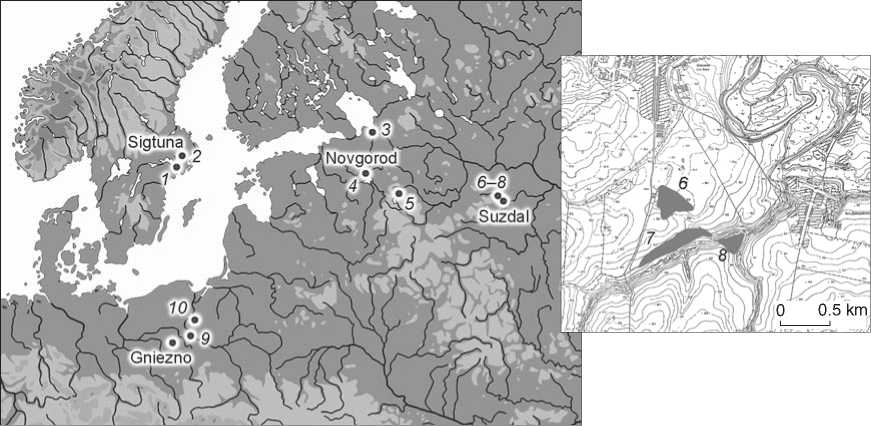
Fig. 1 . Medieval cemeteries which skeletal evidence was used to study the strontium isotopic composition.
1 – Birka; 2 – Sigtuna; 3 – Ladoga, necropolis near the Church of St. Clement; 4 – Novgorod; 5 – Poddubye; 6 – Shekshovo-9;
7 - Shekshovo-2; 8 - Bolshoye Davydovskoye-2; 9 - Bodzia; 10 - Cieple.
Despite the presence of weaponry and festive male clothing in the burial inventory, which gives the site a special flavor, Shekshovo-9 is a cemetery with standard sex and age distribution of the buried persons with a proportional representation of males, females, and children. The funeral rite, with all variety of its specific forms, was focused on demonstrating the prestige and high wealth of medieval settlers of Shekshovo. Common elements for many sites of the 10th– 11th centuries, which are traditionally viewed as testimonies of social prestige and participation in commodity-money relations (including Eastern, Byzantine, and Western European coins, weights and parts of scales for weighing light loads) appear there in an extremely vivid way.
Shekshovo is a necropolis of one of the largest settlement agglomerations of the 10th to the first half of the 13th century in the Suzdal Opolye (complex of settlements of Shekshovo-2–Bolshoye Davydovskoye-2), which at the early stage of its existence (10th– 11th centuries) can be described as a large settlement. The total area of sites with cultural layer of the 10th– 11th centuries covers at least 15 hectares. Material evidence from excavations and collections characterize this site as a complex with a sophisticated, multicomponent culture, where the Old Russian and Volga-Finnish traditions are clearly expressed and where Scandinavian elements are present, and as a settlement with its own agricultural life supporting system, craftsmanship, and wide trade ties (Fig. 2). The Shekshovo agglomeration was one of the

ю ю mu о co о wo wo
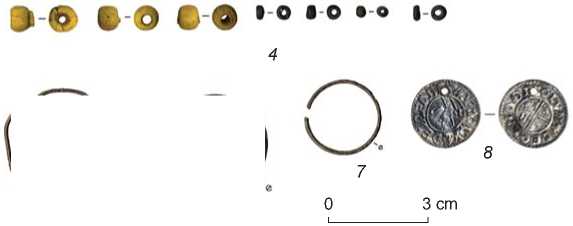
Fig. 2 . Grave goods from burial 12 (first half of the 11th century) at Shekshovo-9.
1 – ring; 2 – knife; 3 , 5–7 – temple rings; 4 – beads; 8 – pendant coin (England, Ethelred II, London, Leofnod coiner, 991–997);
9 , 10 – vessels. 1 , 3 , 5–7 – non-ferrous metal; 2 – iron; 4 – glass; 8 – silver; 9 , 10 – ceramics.
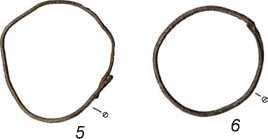
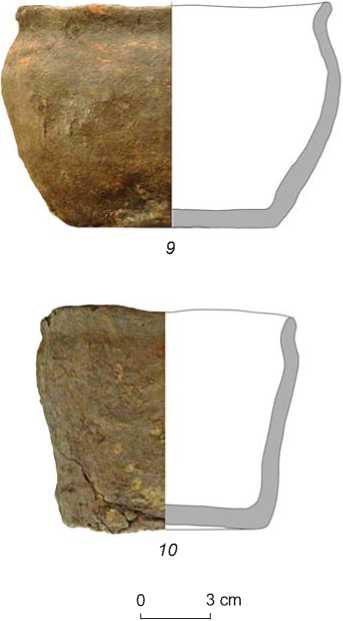
most important centers of the new settlement network that emerged in the center of the Volga-Oka region in the 10th century (Fedorina, Krasnikova, 2015; Makarov, Fedorina, 2015; Makarov, Fedorina, Shpolyansky, 2018). The presence of two other cemeteries in the microregion, corresponding to the earlier stage of its development (Bolshoye Davydovskoye-2, late 3rd– 4th centuries) and to the final stage of habitation at the settlement (Shekshovo-2, late 12th–13th centuries), make it possible to use paleoanthropological evidence from other periods for comparative study and to follow bioarchaeological approaches in a diachronic context. The data on the strontium isotopic composition of dental enamel and bone tissue provide the needed means for reconstructing the mobility and migration activity of medieval people living in the Suzdal Opolye.
Methodological aspects of studying the isotopic composition of strontium in material evidence from the medieval sites of the Suzdal Opolye
Data on the isotopic composition of strontium in bone tissue and dental enamel of persons whose remains were found at archaeological sites are successfully and widely used for evaluating population mobility. The share of strontium isotopes in the environment is primarily determined by the geological deposits on which the local flora grows and by the mineral composition of drinking water. This method has been actively used in archaeology for over ten years, but numerous methodological difficulties continue to be discussed (Bentley, 2006; Frei et al., 2015). The first step of research is to clarify the boundaries of the local variability of strontium composition in local biota and water. In the case when individual data are beyond the local values of the 87Sr/86Sr ratio, the person, animal, or material of biological origin (leather, wool, textiles made of wool, silk, plants, etc.) should be considered to have been formed or spent the last years of life outside that specific area. The most preferred object of study is dental enamel, because it is least susceptible to the impact of factors that may transform the lifetime isotopic composition in the soil of the burial. Compact bone tissue of good preservation can also be used for analysis.
It is important to keep in mind that dental enamel on each tooth (baby tooth or permanent tooth) is formed over a certain period of time. When, for example, enamel of the first upper incisor is used as a sample, the isotopic composition of strontium will reflect the total characteristics of a person’s habitation for about three to four of his first years of life, while his compact bone tissue will reveal the characteristics for the last seven to ten years of life. Thus, when analyzing dental enamel, we can learn about a specific period in the childhood of that person. The data obtained from compact bone tissue inform us about the average parameters of his habitation over the last seven to ten years of life.
Data on the isotopic composition of strontium in the dental enamel of baby teeth require special interpretation. These teeth emerge in the period of intrauterine development, and the composition of the enamel will reflect specific features of both the nutrition of the woman in whose body the child is developing, and the environment (food and drinking water). Analysis of dental enamel, for example, of the central baby incisor of the maxilla will give us an idea on the environment of the mother during her pregnancy and the newborn infant in the first months of life.
The term “mobility” has been widely used in bioarchaeological literature for describing the intensity of a person’s movements throughout his life. Most often, scholars use information on the composition of dental enamel; therefore, the conclusion about the level of mobility is usually made from whether the person lived in the given area in his childhood or not. Presence of remains of people who spent their childhood in other lands in the burials can be interpreted as manifestation of mobility. Yet these data may indicate either one resettlement or many movements. Analysis of the isotopic composition of strontium in teeth enamel only partially reveals the history of the person’s mobility. When comparing the data obtained from dental enamel and bone tissue, the opportunities for assessing one’s mobility increase. Bone tissue undergoes constant restructuring; its composition changes throughout the entire life. Therefore, a detailed description of the type of bone tissue and of a bone fragment makes it possible to determine with greater accuracy which period of a person’s life is characterized by the value of the ratio of strontium isotopes obtained.
The possibility of studying cremated remains has been substantiated in a number of studies (Snoeck et al., 2018). Such material evidence is important for assessing migration intensity of the medieval population in the period preceding the spread of Christianity and the rite of inhumation. The isotopic composition of strontium in cremated bones was established by K.M. Frei in collaboration with the National Museum of Denmark. Results were obtained at the Department of Geosciences and Natural Resource Management at the University of Copenhagen. The ratio of strontium isotopes in 29 samples was established at the Center for Isotope Research of the Karpinsky Russian Geological Research Institute (St. Petersburg) by E.S. Bogomolov, and at the Institute of Geology and Geochemistry of the Ural Branch of the Russian Academy of Sciences (Yekaterinburg) by D.V. Kiseleva.
Reconstruction of population mobility in the Suzdal Opolye
The Vladimir-Yuryev Opolye is a unique natural phenomenon, which ensured the successful development of the medieval arable agriculture. Formation of fertile soil was largely fostered by the nature of the upper part of the Quaternary cover, which consisted of an undivided complex of subaerial, loamy deposits on underlying low-carbonate moraine. Therefore, it is possible to identify local residents and migrants based on geochemical features of the territory. To obtain the boundaries of the local variations in 87Sr/86Sr values, we used the principle of geomorphological diversity (Dobrovolskaya, Reshetova, 2018). Shells of bivalve mollusks associated with the main source of water were collected, and plant samples were taken in terraced and floodplain areas near the Irmes River next to the cemetery. The boundaries of local variability were confined to the values of 0.71041– 0.71575 (Frei et al., 2016).
Most of our samples were dental enamel or tooth root (see Table ). One sample was organic matter from a humic accumulation of soil in the cultural layer of Shekshovo-9. Only one person was represented by the samples of dental enamel and compact bone tissue. The range of 87Sr/86Sr values obtained from the analysis of human skeletal remains was 0.7098–0.7211. Most of the individual values were within the limits of local variability (Fig. 3), and more than two thirds of the values were within the narrower range of 0.710–0.712. The values of the isotope ratio in the dental enamel of animal teeth indicate their local origin. All cremated bone samples show values similar to baseline numbers. The exception was the skeletal remains of the persons buried according to the inhumation rite from the Shekshovo-2 cemetery, and four ground burials from Shekshovo-9 (Fig. 4). We will dwell on them in more detail.
Burial 14 was one of the earliest inhumations at Shekshovo-9, dated to the late 10th to early 11th century. It belonged to a person of 15–19 years of age and a female, judging by the jewelry. The anthropological determination of sex did not contradict this conclusion. The isotopic composition of strontium in the upper incisor enamel is formed in the period from 0.5 to about 4 years of age. The obtained value of 87Sr/86Sr (0.70986) indicates the presence of that girl in a different geochemical environment at an early age.
Burials 8 and 11 (excavations of 2014) were children’s; both were dated to the 11th century. The age of the child from burial 8 was 3–4 years. The enamel from the germ of the first upper permanent molar was used as a sample. The 87Sr/86Sr ratio was 0.716252. Similar values were obtained, for example, from the paleoanthropological evidence from the south of Novgorod Region (Dobrovolskaya, Reshetova, 2018: 14).
The crown was formed at the age of 2–3.5. Thus, the child was born and lived in his first years of life in another area, and shortly before his death moved to the Opolye. Obviously, he could have moved there only with his relatives. The child from burial 11 was somewhat older, although poor preservation of his remains did not make it possible to establish his age accurately. The enamel from the germs of the first molars was also used as a sample. The 87Sr/86Sr ratio was 0.721159, the highest in the sample. It can be associated, for example, with the territory of Scandinavia (Price, Moiseyev, Grigoreva, 2019: 6098). This person was also born and spent the first two or three years of life outside the Suzdal Opolye, and moved there shortly before the person’s death. The presence of such children in the paleopopulation most likely reflects the migration of families or groups of relatives. The small number of cases and the fact that the samples belonged to children do not yet make possible a sound discussion of these facts.
Three burials of individuals identified as “natives born in other territories” were located in the same section of the necropolis and belonged to flat graves of the 10th– 11th centuries.
Burial 8 (excavations of 2017) stands out among the majority of burials at Shekshovo-9 by its isolated location, unusual orientation (southern), and position of hands (folded on the chest). Judging by the presence of an oval fire striker with a prong, the burial can be dated to no later than the mid 12th century, most likely to its first half. The 87Sr/86Sr ratio in the canine tooth was 0.71194 and corresponded to the local variation range. Based on this indicator, this person could have been born locally. However, the 87Sr/86Sr value in the compact bone tissue of his fibula was significantly lower, reaching only 0.70989, beyond the limits of local variability. Thus, the male from burial 8 spent his childhood in the Suzdal Opolye, lived the last years of his life in other lands, and was buried in his homeland. Comparison of isotopic parameters in dental enamel and bone samples makes it possible to evaluate his mobility. It is interesting that the ratio of strontium isotopes characterizing the childhood environment of the girl buried in burial 14, and the last years of life of the male whose remains were found in burial 8, were almost identical. This may indicate the existence of stable links between the Suzdal Opolye and the territory with this geochemical value.
Two burials from Shekshovo-2 belonged to males of 25–35 years of age. They are in a part of the necropolis that emerged at the settlement of the same name in the late 12th century after abandoning the northern section of the settlement previously occupied by residential buildings. The values of the ratio of strontium isotopes in dental enamel of these individuals were close to the values obtained in the analysis of dental enamel of the girl from burial 14 and bone tissue of the male from
The ratio of radiogenic strontium isotopes in the samples from the Sekshovo-2 and -9 cemeteries
|
Year of excavations |
Place of discovery, sex, age |
Sample |
Comment |
87Sr/86Sr, ‰ |
|
Shekshovo-2 |
||||
|
2007 |
Burial 1, adult male |
Upper premolar enamel |
Inhumation |
0.71009 |
|
2011 |
Burial 2, adult male |
Upper incisor enamel |
ʺ |
0.70981 |
|
Shekshovo-9 |
||||
|
2012 |
Excavation 1, burial 1, male, 30–45 years old |
Third upper molar enamel |
ʺ |
0.71019 |
|
2012 |
Area 1, sq. 579/092в, adult individual |
Tubular bone |
Cremation |
0.71140 |
|
2012 |
Sq. 574/080, plowed soil |
Dental enamel |
Bovine cattle |
0.71222 |
|
2013 |
Excavation 2, brown layer, upper part of the ditch, sq. 584/063, adult individual |
Tubular bone |
Cremation |
0.71169 |
|
2013 |
Excavation 2, sq. 583/068, upper part of the ditch, adult individual |
Tubular bone |
ʺ |
0.71040 |
|
2013 |
Burial 1, female, 30–39 years old |
Lower canine enamel |
Inhumation |
0.71072 |
|
2013 |
Burial 2, male, 40–49 years old |
Molars enamel |
ʺ |
0.71153 |
|
2013 |
Burial 4, child, 6–7 years old |
Lower premolar enamel |
Tooth germ, inhumation |
0.71050 |
|
2013 |
Burial 5, female, 20–29 years old |
Lower canine enamel |
Inhumation |
0.71050 |
|
2013 |
Burial 6, child, 3–4 years old |
First molar enamel |
Tooth germ, inhumation |
0.71133 |
|
2014 |
Burial 7, male, 40–49 years old |
Cranial vault |
Inhumation |
0.71153 |
|
2014 |
Burial 8, child, about 3–4 years old |
First molar enamel |
Tooth germ, inhumation |
0.71625 |
|
2014 |
Burial 11, child, 3–6 years old |
Molars enamel |
Teeth germs, inhumation |
0.72116 |
|
2014 |
Burial 12, female, 30–39 years old |
Upper premolar enamel |
Inhumation |
0.71154 |
|
2015 |
Burial mound 11, western ditch |
Dental enamel |
Horse, inhumation |
0.71208 |
|
2015 |
Burial 14, female, 15–19 years old |
Upper incisor enamel |
Inhumation |
0.70986 |
|
2015 |
Burial 15, child, about 10 years old |
Second lower molar enamel |
Tooth germ, inhumation |
0.71105 |
|
2016 |
Burial mound 12, adult male |
Root of lower canine |
Cremation |
0.71020 |
|
2016 |
Burial mound 8, southwestern ditch, sq. 573/051 |
Dental enamel |
Horse |
0.71020 |
|
2017 |
Excavation 1, burial 5, male, 20–29 years old |
Upper first premolar enamel |
Inhumation |
0.71160 |
|
2017 |
Excavation 2, burial 6, female, 20–29 years old |
Upper second molar enamel |
ʺ |
0.71136 |
|
2017 |
Excavation 1, burial 7, child, about 3 years old |
Upper canine enamel |
Tooth germ, inhumation |
0.71286 |
|
2017 |
Excavation 1, burial 8, male, 30–39 years old |
Upper canine enamel |
Inhumation |
0.71194 |
|
2017 |
ʺ |
Compact tubular bone (fibula) |
ʺ |
0.70989 |
|
2018 |
Excavation 4, burial 9, child, about 9 years old |
Second molar enamel |
Deciduous tooth, inhumation |
0.71164 |
|
2018 |
Excavation 4, burial 10, male, 40–49 years old |
Upper second molar enamel |
Inhumation |
0.71022 |
|
2013 |
Sq. 640/089, accumulation 1, black layer |
Organic matter in soil |
– |
0.71204 |
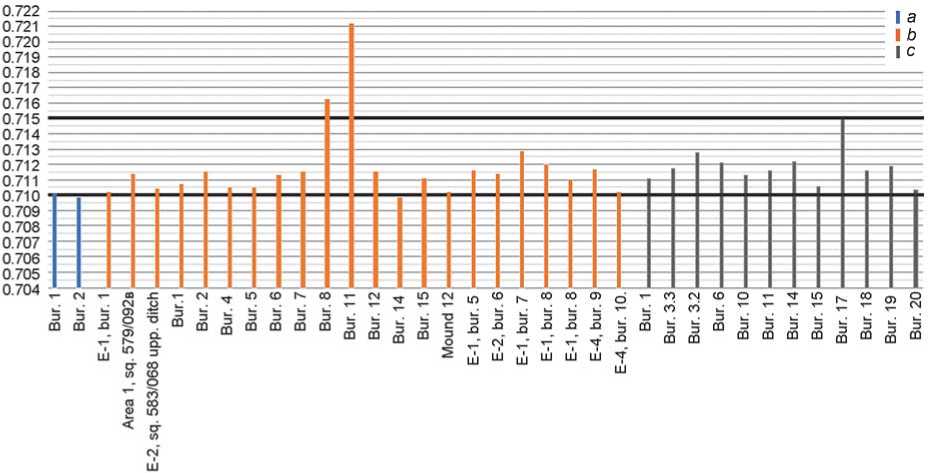
Fig. 3 . Ratio of strontium isotopes in dental enamel and bone tissue of people buried at Shekshovo-2 ( a ), -9 ( b ), and Bolshoye Davydovskoye-2 ( c ).
Fig. 4 . Ground plan of burials with designation of “born locally” and “migrants”, identified by the isotopic composition of strontium, at Shekshovo-9.
a – “born locally”; b – “migrants”; c – “born locally” but living outside the Suzdal Opolye in the last years of life; d – no data on the isotopic composition of strontium; e – burials made according to the cremation rite; f – cremated remains of unidentified location found outside large clusters.
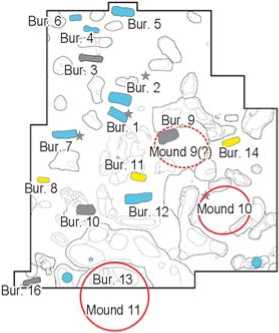
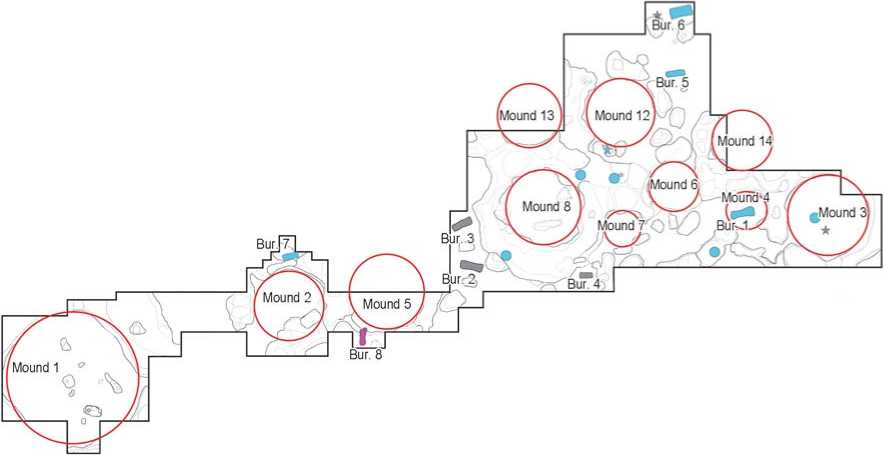
0 5 m
■а b
■c
■d
e
•f
burial 8 at Shekshovo-9, which confirms the hypothesis on the existence of territories that had stable connections with the Suzdal Opolye.
Discussion
Overall, the results obtained suggest a predominantly local origin of the people buried at the Shekshovo-9 cemetery. The addition of persons born in other areas to this group was small, but can be observed at all stages of the necropolis’ functioning. It is important that samples from burials performed according to different rites (cremation and inhumation under a burial mound, or inhumation without a burial mound) provide similar values of strontium isotopes. Notably, burial mound 8 where the complex contained a set of bridle elements, according to I.E. Zaitseva, was associated with the nomadic world (2017). The results of isotope analysis indicate the local origin of two persons whose burials contained coins placed in the graves as “Charon’s obol”—whole dirhems and cut pieces of coins (burial 1, excavations of 2012; burial 5, excavations of 2017). Such a custom was rare in Medieval Rus. It is possible that it was spread by mobile tradesmen, but the isotope data do not support this assumption. In terms of 87Sr/86Sr values, the persons from several burials of the first half of the 11th century, which were performed according to the inhumation rite, should be recognized as “local” (burial 1, excavations of 2013; burial 12, excavations of 2014; burials 5 and 6, excavations of 2017). Thus, the emergence of this rite, including the custom of burying in large pits, as well as presence of prestigious imported items in material complexes, in particular Western European and Byzantine coins, was not associated with the arrival of migrants to Shekshovo. New forms of funeral rite, reflecting the emergence of Old Russian cultural norms and abandonment of pagan traditions, entered the everyday life of the local population in the first half of the 11th century. The only burial of a newcomer identified by the isotope markers (burial 8, excavations of 2017) is distinguished by an unusual funeral rite.
For comparative assessment of mobility of the people leaving behind the Shekshovo-9 necropolis, we should turn to available data on isotopic composition of strontium in the skeletal remains from Bolshoye Davydovskoye-2 of the Early Iron Age (Makarov, Krasnikova, Zaitseva, 2010). We compared two groups of people who lived on the same territory, but were separated by seven to eight centuries. Samples of bone tissue and dental enamel represented 11 persons of different sex and age from Bolshoye Davydovskoye-2. The range of the values obtained for 87Sr/86Sr was 0.710334–0.715177. None of the individual indicators significantly exceeded the boundaries of local variability. The arithmetic average values for the series from Bolshoye Davydovskoye and Shekshovo were identical up to three decimal places (0.7117 and 0.7118, respectively), and the standard deviation for the medieval group was twice as large. This made it possible to assume that persons from Shekshovo-9 could have originated in different parts of some geochemically unified space. The necropolis might have been the burial place for not only one large agglomeration of settlements, but also for its surrounding areas. The lifestyle of the Early Iron Age people leaving behind the Bolshoye Davydovskoye-2 cemetery was also distinguished by moderate mobility. However, is there a risk that the range of local variations in values is too large and does not make it possible to assess the mobility of ancient groups in this region?
The nearest place with known data on variability of the strontium isotopic composition is Yaroslavl, located about 100 km to the north of Shekshovo. Excavations of the medieval layers in Yaroslavl, corresponding to the time of Khan Batu’s invasion, have made it possible to collect rich osteological evidence. The data on the isotopic composition of strontium in the skeletons of humans and animals was obtained. There is reason to believe that not only local residents, but also people from other territories were in the town during its capturing, so we cannot rely on individual data of the buried from collective graves. It is more important that the boundaries of local variability were identified on the basis of ancient and modern local fauna. The local values ranged from 0.7119 to 0.7137 (Engovatova et al., 2015: 120). Most of the individuals from Shekshovo, as has been mentioned above, are characterized by a strontium ratio from 0.710 to 0.712, which differ from the values typical of the territory of Yaroslavl. This indicates that the method is effective in distinguishing between the groups of local residents.
Two out of the four persons from Shekshovo-9 who could be called migrants had 87Sr/86Sr values below local values (burials 14 and 8). The values of 0.7098 and 0.7099 have been observed in more southern regions of the Russian Plain. The lower values are typical of the Caucasus, where rocks of magmatic or metamorphic origin are present (Shishlina et al., 2016: 35).
Generally, the value of 87Sr/86Sr in the samples from Shekshovo-2 and -9 tends to be low within the limits of local variability. Note that earlier examination of woolen fabric from Shekshovo showed a value of 0.70999 (Frei et al., 2016), which is comparable with that of an individual from burial 14, one of the earliest burials.
We should consider the ratios of strontium isotopes in the samples from burial sites that are chronologically close to the Shekshovo cemetery and are also associated with the emergence of power centers (see Fig. 1). Bodzia and Cieple are necropolises with burials of the military elite of the late 10th to first half of the 12th century in Poland. Northern Europe is represented by burials from Birka (8th–10th centuries), Sigtuna (10th–12th centuries), and Staraya Ladoga near the Church of St. Clement (11th– 12th centuries).
The isotopic composition of strontium in dental enamel of individuals from the Cieple cemetery has revealed a high percentage of “non-residents”. Individual values (21 individuals) ranged from 0.7096 to 0.7115. The authors of the study suggested that individuals with values below 0.7102 (amounting to about half) were recent migrants. This group included those buried both in burial chambers and in single graves. Presumably, these people were the natives of Denmark, Southwestern Sweden, Western Norway, Rügen Island, and Southeastern Poland (Belka et al., 2019).
The study of 13 samples from the elite burials of the Bodzia necropolis has shown that only one individual could be recognized as locally born resident (Price, Frei, 2015: 458). This probably indicates an exceptional importance of the settlement that attracted people from other regions. Variability of the indicator among the migrants was not high, ranging within 0.7090–0.7129. The authors observed that such values are typical of many European territories with blanking deposits associated with loess and presence of carbonates.
The scatter of values for the burials of Early Medieval Birka was significant and ranged from 0.71026 to 0.73425 against the baseline of local variations within 0.722–0.732 (Price et al., 2018: 32). The 87Sr/86Sr values in the samples from Sigtuna varied from 0.7080 to 0.74215, with a local range of 0.7167–0.7323 (Krzewinska et al., 2018: 2733). Over a half of the 36 individuals were “non-residents”. The samples from Staraya Ladoga also showed a wide range of values from 0.7105 to 0.7334. Persons presumably related by their origin in Southeastern Sweden, Finland, and Northwestern Russia were identified. It is difficult to distinguish those born locally because of possible intersection in local isotopic characteristics with those of the Gotland Islands and some other territories. In any case, the group included a significant share of “non-residents” (Price, Moiseyev, Grigoreva, 2019: 6107).
Thus, the resulting picture is diverse. People from different territories were buried at the necropolises of Bodzia, Birka, Sigtuna, and Staraya Ladoga. About half of the persons buried in Cieple were first generation migrants. In Shekshovo, only a few buried persons were people from other territories. When comparing the areas where the “migrants” originated, a zone with variations in the isotopic strontium ratio in the approximate range of 0.708–0.710 was distinguished. Scholars who studied the evidence from the Bodzia necropolis suggested that some of the buried originated in the Kiev lands and were associated with the retinue of Svyatopol, who relied on the military support of Boleslav I in the struggle for Kiev, based on some finds from burials and identification of a group of migrants with indicators ranging between 0.709 and 0.710 (Price, Frei, 2015). Some migrants from
Shekshovo could have been associated with the southern Russian lands. We should also mention that similar values (0.709–0.710) characterize territories favorable for arable farming. Assessment of mobility of the people leaving behind the cemeteries of Bodzia, Cieple, and Shekshovo reveals significant differences in the history of emergence of these population groups.
Conclusions
The study of the strontium isotopic composition in skeletal remains from Shekshovo-9 is one of the first experiments in reconstructing mobility of people in the 10th–11th centuries, associated with the emergence of a new settlement network in the north of the Russian Plain. When archaeologists address this topic, they traditionally focus on the evidence that may reveal movements, migrations, long-distance trade traveling, presence of people from different ethnic backgrounds in medieval groups, and special lifestyle emphasizing the prestige of military and trade pursuits. The first results of studying the isotope markers indicating the mobility of Shekshov settlers do not fully correspond to the expected pattern of high mobility of the medieval population from Northeastern Russia. People buried in the necropolis at one of the largest settlements of the 10th–11th centuries in the Suzdal Opolye, included into the system of princely administration, were mostly born locally. Future studies will show whether these observations reflect specific features of the historical and cultural situation in the Shekshov microregion or more general patterns.

